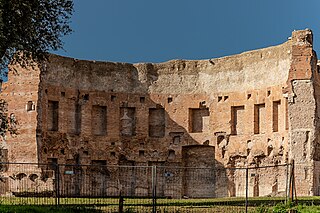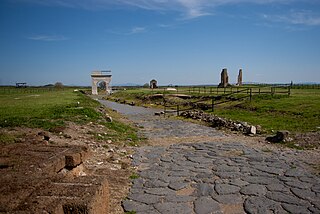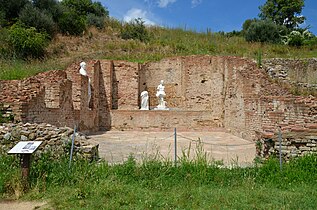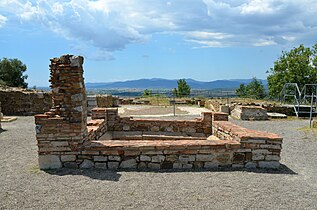
Ancient Roman architecture adopted the external language of classical ancient Greek architecture for the purposes of the ancient Romans, but was different from Greek buildings, becoming a new architectural style. The two styles are often considered one body of classical architecture. Roman architecture flourished in the Roman Republic and to an even greater extent under the Empire, when the great majority of surviving buildings were constructed. It used new materials, particularly Roman concrete, and newer technologies such as the arch and the dome to make buildings that were typically strong and well engineered. Large numbers remain in some form across the former empire, sometimes complete and still in use today.

Grosseto is a comune in the central Italian region of Tuscany, the capital of the province of Grosseto and of the Maremma. The city lies 14 kilometres from the Tyrrhenian Sea, at the centre of an alluvial plain on the Ombrone river.

Castiglione della Pescaia, regionally simply abbreviated as Castiglione, is an ancient seaside town in the province of Grosseto, in Tuscany, central Italy. The modern city grew around a medieval 12th century fortress and a large fishery, from which it acquired its designation. Today Castiglione is a very popular tourist destination with attractions that include beaches, natural parks, biking trails, historical Etruscan archaeological sites, a panoramic mediaeval hamlet as well as the natural reserve Diaccia Botrona, a swampy humid environment of historical relevance whose endangered wildlife comprise pink flamingoes, mallards and ducks.

Otricoli is a town and comune in the province of Terni, Umbria, central Italy. It is located on the Via Flaminia, near the east bank of the Tiber, some 70 km north of Rome and 20 km south of Narni.

Hispellum was an ancient town of Umbria, Italy, 6 km (3.7 mi) north of Fulginiae on the road to Perusia.

The Baths of Trajan were a massive thermae, a bathing and leisure complex, built in ancient Rome and dedicated under Trajan during the kalendae of July 109, shortly after the Aqua Traiana was dedicated.

Vulci or Volci was a rich Etruscan city in what is now northern Lazio, central Italy.

Vetulonia, formerly called Vetulonium, was an ancient town of Etruria, Italy, the site of which is probably occupied by the modern village of Vetulonia, which up to 1887 bore the name of Colonnata and Colonna di Buriano: the site is currently a frazione of the comune of Castiglione della Pescaia, with some 400 inhabitants.

Feronia or Lucus Feroniae was an ancient Roman municipium border the present Via Tiberina and Autostrada A1, current Comune of Capena near the present town of Fiano Romano. It is located in the plain along the Tiber Valley, at the foot of Mount Soracte, and was within the ancient territory of Capena. It began as a sanctuary called Lucus Feroniae in the time of Tullus Hostilius when it was located in Etruria.

Gavorrano is a mountain-side comune (municipality) in the Province of Grosseto in the western Italian region of Tuscany, located about 100 km (62 mi) southwest of Florence and about 25 km (16 mi) northwest of Grosseto. Gavorrano borders the municipalities of Castiglione della Pescaia, Grosseto, Massa Marittima, Roccastrada and Scarlino.

Santa Marinella is a comune (municipality) in the Metropolitan City of Rome Capital, in the Italian region of Lazio, located about 60 kilometres (37 mi) northwest of Rome.

Sovana is a small town in southern Tuscany, Italy, a frazione of Sorano, a comune in the province of Grosseto. It is one of I Borghi più belli d'Italia.

The House of the Faun, constructed in the 2nd century BC during the Samnite period, was a grand Hellenistic palace that was framed by peristyle in Pompeii, Italy. The historical significance in this impressive estate is found in the many great pieces of art that were well preserved from the ash of the eruption of Mount Vesuvius in 79 AD. It is one of the most luxurious aristocratic houses from the Roman Republic, and reflects this period better than most archaeological evidence found even in Rome itself.

The Gardens of Maecenas, or Horti Maecenatis, constituted the luxurious ancient Roman estate of Gaius Maecenas, an Augustan-era imperial advisor and patron of the arts. The property was among the first in Italy to emulate the style of Persian gardens. The walled villa, buildings, and gardens were located on the Esquiline Hill, atop the agger of the Servian Wall and its adjoining necropolis, as well as near the Horti Lamiani.

Capo Colonna is a cape in Calabria located near Crotone. In ancient Roman times the promontory was called Promunturium Lacinium. The modern name derives from the remaining column of the Temple of Hera Lacinia.

Istia d'Ombrone is a small town in southern Tuscany, Italy, a frazione of the comune of Grosseto.

Roselle is a frazione or village in the comune of Grosseto. The archaeological remains of the ancient city of Rusellae are located to the northeast of the modern settlement.

Batignano is a small town in southern Tuscany, a frazione of the comune of Grosseto, positioned at about 10 km north-east of the capital on one of the last foot-hills of the valley of Ombrone which dominated the ancient city of Roselle.

Castellaccia is a village in Tuscany, central Italy, administratively a frazione of the comune of Gavorrano, province of Grosseto. At the time of the 2001 census its population amounted to 79.

Castrum Novum was an ancient Roman town now located in the suburbs of Santa Marinella, to the north of Cape Linaro, Italy. Nearby on Mount Guardiole, 1.5 km from the coast, was an Etruscan settlement.
































